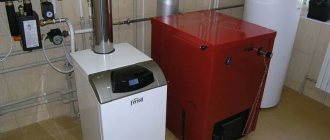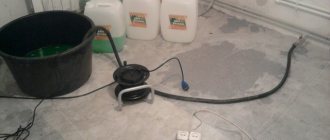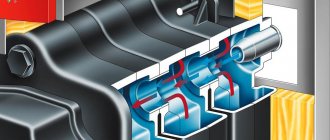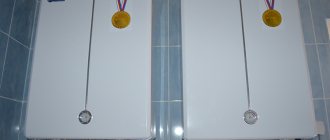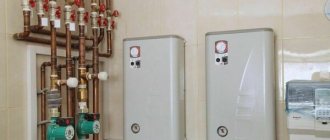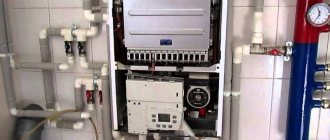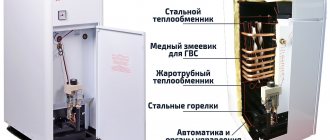If a gas main is connected to the house, you can choose a gas boiler without further hesitation: this is the most profitable, least labor-intensive and completely autonomous option for organizing heating. Floor-standing models are heavier, relatively simple and reliable; they can be equipped with a durable cast-iron heat exchanger with a service life of more than 30 years. They can work with almost any coolant.
In this material, we tried to describe in as much detail as possible all the criteria and nuances of choosing a floor-standing gas boiler, and gave examples of the most successful, efficient and best price-quality ratio household single-circuit and double-circuit floor-mounted gas boilers for 2020.
What are floor-standing gas boilers?
Modern gas floor-standing boilers have an excellent design, compact size and operate almost silently, so they can be installed in any room in a private home that meets the requirements.
A gas floor-standing boiler is a stationary, single-circuit or double-circuit, most often atmospheric and energy-independent, central element of the heating system, responsible for the generation of thermal energy. In most cases, floor-standing models are not equipped with a circulation pump, air vent, safety valve and other heating system elements found in wall-mounted models.
Floor-standing models are more versatile, less dependent on weather conditions, gas and coolant quality, and according to operating practice and service call statistics, they are more reliable and problem-free. Like wall-mounted ones, they can operate on natural and liquefied (ballooned) gas; to switch to the latter, just change the burner. Prices for the most budget gas floor-standing boilers start from 12-13 thousand rubles.
Design and principle of operation
The device using the example of a floor-standing single-circuit Vaillant atmoVIT VK INT 164/1-5.
The design and principle of operation may differ slightly from model to model, but in most cases modern models operate on the same principle as classic old-style boilers, only the materials, manufacturing technologies and design efficiency have changed:
- Natural gas is supplied from the gas main through the burner nozzles into the combustion chamber.
- Using piezo ignition (by pressing a button in non-volatile boilers) or electric ignition (automatically in energy-dependent boilers), the pilot light is ignited, igniting the main burner.
- Upon reaching the set coolant temperature, the gas supply stops and the gas burner goes out, the igniter continues to burn.
- When the temperature drops, the gas supply is resumed and the igniter ignites the main burner again.
- The walls of the combustion chamber are a heat exchanger within which the coolant circulates. The coolant distributes the accumulated thermal energy throughout the heating system, releasing heat through radiators, after which it is returned back to the boiler.
- The oxygen needed to burn the gas is taken in through holes in the bottom of the boiler. Combustion products are discharged through the chimney through natural draft.
This is how classic non-volatile atmospheric (with an open combustion chamber and vertical chimney) models work. More expensive floor-standing gas boilers also come with a closed combustion chamber, they are also turbocharged. Air for gas combustion is forced into them using a turbine, which increases combustion efficiency. In this case, combustion products are discharged into them through a coaxial (side) chimney, as in most wall-mounted models, which greatly simplifies installation and room requirements. We will further analyze this selection criterion further.
Separately, it is worth noting parapet boilers, which buyers mistakenly often call chimneyless. They are neither wall-mounted nor floor-mounted and are equipped with a coaxial chimney, which is integral with the boiler. We have already written in the corresponding article why this option should not be considered.
Is it worth considering parapet gas boilers for heating a private home?
Distinctive features of Russian gas boilers
The most important feature is the low cost of domestic boilers. This is achieved through the absence of customs duties, often lower transportation costs, cheaper labor, lower component costs and lower technology research costs. However, every year Russian models become more and more efficient and functional, and prices in foreign currency equivalent remain practically unchanged.
Adaptation to domestic conditions is also important: low pressure of natural gas in the main, voltage drops. Many Russian models, unlike rare foreign ones, are non-volatile, i.e. do not require connection to the electrical network; the automation is powered by a heating thermocouple.
The device is based on the example of the domestic two-circuit model Conord KSts-g-30N: minimum number of components, simple materials, simple non-volatile automation.
A simple design and operating principle are the key to easy and quick troubleshooting. Finding a competent specialist is not a problem even in regions remote from the capital.
However, Russian gas boilers have a lower efficiency, on average 4-6%, which means not only lower heating output, but also often higher gas consumption. Domestic models are less automated and less safe. Starting in most models is done manually, using piezo ignition; as mentioned earlier, there are usually no additional protective functions.
Reviews of domestic gas boilers: advantages and disadvantages
Based on technical characteristics, installation practices and owner reviews, you can clearly weigh all the pros and cons of boiler units:
| Advantages | Flaws |
| The vast majority of models have a price accessible to everyone, lower in comparison with analogues | Optimal, but still lower efficiency in comparison with foreign analogues |
| Huge selection of non-volatile models | Lower reliability and build quality, shorter service life |
| Boilers operate at almost any gas pressure in the main line | Lack of options with modulating burners |
| There are successful parapet models that can also be used for heating apartments | Limited automation, which affects not only ease of use, but also gas consumption |
| Low cost of components, you can find and replace them without problems, in a short time | Almost all models are floor-standing, single-circuit, heavy and require more boiler room space |
| Finding a competent specialist in the regions is not a problem | Usually there is no protection against overheating or freezing, stopping the circulation pump, or protection against reverse draft |
| In practice, noisier operation is noticeable; most models lack heat and noise insulation |
Reviews of domestic gas floor-mounted models: advantages and disadvantages
| Advantages | Flaws |
| High reliability and service life due to the possibility of installing a heavy cast iron heat exchanger and a simpler, more reliable device | Often lower efficiency than wall-mounted models |
| More than half of the models are non-volatile, yet efficient, often with an efficiency of more than 90% | The basic package rarely includes an expansion tank, circulation pump, safety group and other elements of the heating system |
| Offers a wider choice of power ranges when compact wall-mounted designs are limited in performance | Large dimensions and weight, more complex, requiring special skills, installation |
| According to reviews from owners and operating practice, low requirements for coolant and gas | Most often, automation is simpler and less functional, compared to wall-mounted models. |
| Full autonomy of operation, requiring no human intervention | The need for a separate boiler room that meets the requirements |
| Large selection of models, the most budget ones are much cheaper than wall-mounted ones and start from 12-13 thousand rubles | Functional and ultra-efficient models with advanced automation cost more than 80-100 thousand rubles. |
| Requires much less regular cleaning and maintenance than wall-mounted | Budget floor-standing boilers are much less often equipped with modern safety systems (against overheating, freezing, pump blocking), but this does not mean that they are not safe at all. |
The best manufacturers of gas water heaters
The reliability and quality of heating equipment directly depend on the brand. The most famous manufacturers of gas floor-standing boilers are the following companies.
- Lemax is a Russian manufacturer of heating equipment from Taganrog. Gas heaters from this company are highly reliable and affordable.
- BAXI is an Italian manufacturer of heating equipment. The history of the company dates back to 1924. The products of this brand are of the highest quality, confirmed by various international certificates.
- Protherm is a manufacturer from Slovakia. The brand is relatively young, however, thanks to the quality of its products, it is among the top manufacturers of heating equipment. The company belongs to the German giant Vaillant Group. To improve product quality, it uses the “one boiler – one master” assembly technology.
- MORA is a Czech company that is part of the Gorenje Group corporation. Its history begins in 1825. During this time, it has established itself as a first-class manufacturer of heating equipment.
- Pechkin is a manufacturer of heating equipment from Russia. The company is located in the city of Taganrog. The products of this company are highly reliable and unpretentious.
How to choose a floor-standing gas boiler
There is no definite decision in the choice, since each case is individual and depends on the parameters of the house and preferences, otherwise we could simply list the list of the best models. However, we tried to compile as detailed selection instructions as possible, analyzing absolutely all the parameters, which are enough to understand at least superficially before choosing. Just follow the headings, we have tried to sort them by importance, from most to least.
Volatile or non-volatile
Non-volatile boilers do not require connection to the electrical network and are especially valuable in remote settlements, villages and other places that are characterized by frequent and especially long power outages. They have fairly simple automation, most often the well-known and time-tested Italian EuroSIT. It has only the most minimal functionality necessary to maintain combustion, including safety elements - turning off the gas supply when the pressure drops, the burner goes out or there is no draft.
There is no degree-by-degree temperature control; everything depends on the selected power level; ignition occurs mechanically, by pressing a button. Non-volatile boilers, given the quality of other elements, are extremely reliable, since there is simply nothing to break in them.
Volatile boilers operate only when electricity is available, since they are equipped with a circulation pump, a boost fan and more complex electronic control, which has degree adjustment, various operating modes, the possibility of remote control, etc. Today they are no longer extremely unreliable, as power outages are becoming increasingly rare. However, for homes located in areas where electrical reliability is poor, they are still not suitable. Of course, if you do not plan to install an uninterruptible power supply or generator. Consumption for energy-dependent models is only about 100-250 W.
Single-circuit or double-circuit
Construction of dual-circuit floor-standing models using the example of the domestic budget Conord KSts-g-30N.
Single-circuit boilers are equipped with one water circuit and are intended exclusively for heating. Double-circuit systems, in addition to the heating circuit, have a hot water supply (DHW) circuit, in which, without mixing with the service water of the main circuit, hot sanitary water circulates for domestic needs.
The main advantages of double-circuit boilers are cost (only 10-30% more expensive than single-circuit analogues), which makes them the cheapest option for organizing hot water supply in a house, as well as space saving. However, they also have enough disadvantages. Firstly, the supply speed of prepared water is on average 10 to 20 seconds after opening the tap. Secondly, this time increases with the distance of the pipeline. Thirdly, the productivity of even quite powerful boilers is not enough to prepare water for 3 or more points at the same time (and sometimes for 2).
As a result, a double-circuit gas boiler is the optimal solution for a house with an area of no more than 100-120 m2, with a short distance to points of consumption and lack of space in the boiler room. In houses with a larger area, we recommend installing a combination of a single-circuit gas boiler and an indirect heating boiler.
Detailed comparison of single-circuit and double-circuit boilers Design and principle of operation, expert advice, comparison table
Heat exchanger material
Almost eternal, corrosion and scale resistant cast iron heat exchanger.
The heat exchanger is the main and most valuable element of the boiler, which is the walls of the combustion chamber. The gas burned inside the combustion chamber heats the heat exchanger, around the walls of which a water jacket with coolant is formed. From the heat exchanger, the coolant circulates throughout the heating system, giving off heat through radiators and returning back. The material of the heat exchanger determines its durability and cost. There are two options for floor-standing boilers:
- Steel heat exchanger . Inexpensive to produce and the most common option, installed mainly in models of the budget and mid-price segments. The steel heat exchanger is quite lightweight, resistant to sudden temperature changes and shocks during transportation, and repairable. However, a significant disadvantage is the vulnerability of steel to corrosion. Depending on the thickness of the walls, the quality of the anti-corrosion coating, the quality of the coolant and the frequency of its replacement, the service life of steel heat exchangers is on average 12-18 years, after which the structure leaks.
- Cast iron heat exchanger . Boilers with a cast iron heat exchanger are 2-3 times more expensive than steel ones. The cast iron structure is much heavier and more fragile; it takes longer to heat up, but also retains heat longer after the burner is turned off. A significant advantage is resistance to corrosion, as a result of which the service life of cast iron heat exchangers is usually 30 years or more, and the requirements for the coolant are much lower (almost any uncontaminated water can be used). Please note that a feature of gray cast iron is its vulnerability to sudden temperature changes, therefore in large houses where the temperature difference between the supply and return lines reaches 50-55°C or more, we recommend installing a three-way valve in the piping that mixes hot water into the return line.
Differences between gas boiler heat exchangers
Combustion chamber design and types of smoke removal
The type of combustion chamber determines the method of oxygen intake and emissions removal, room requirements, operating noise and the cost of the boiler.
Open combustion chamber and natural draft
The operating principle of a classic floor-mounted gas atmosphere.
Boilers with an open combustion chamber are also called classic atmospheric, it is their operating principle that we described several points earlier. Oxygen for gas combustion is taken into them naturally, through holes at the bottom of the body, and combustion products are discharged through a vertical chimney, using natural draft. Atmospheric boilers are usually inexpensive and reliable, non-volatile, easier to maintain and operate almost silently; the only source of noise is the burner flame. However, this design also has many disadvantages:
- The efficiency and efficiency of atmospheric boilers is less than that of even the most budget models with a closed combustion chamber.
- Increased requirements for the room and chimney. For normal combustion, the room must be well ventilated, even forced ventilation. To ensure stable draft, the chimney must be designed in accordance with all requirements.
- Atmospheric burners installed in open combustion chambers clog faster and require regular maintenance, although they are easier to clean.
In general, most floor-standing gas boilers are still atmospheric, since the buyer's budget is in most cases limited and a vertical chimney is already installed.
Closed combustion chamber and forced draft
In a closed-type combustion chamber, air flow is carried out from the outside, using a turbocharging fan, so turbocharged boilers are always energy-dependent. To carry out simultaneous intake of air from the street and removal of combustion products, a coaxial chimney is used (lateral, “pipe in pipe”), where exhaust is discharged through the inner pipe, and air is taken in through the gap between it and the outer one. The rotation speed of the turbocharger fan is controlled automatically, so the ratio of the oxygen-gas mixture always remains optimal.
In floor-standing gas models, a closed combustion chamber is used only in expensive models in the highest price segment, starting from 80 thousand rubles. However, this design has many advantages: higher efficiency, which means lower gas consumption; no increased requirements for premises; easier chimney installation.
Comparison of boilers with open and closed combustion chambers
Convection or condensation
We placed this item far from the very beginning, since in the case of floor-standing boilers, most of them are standard convection boilers, described earlier. Condensation models cost from 170-190 thousand rubles, but for the integrity of the picture they are worth mentioning.
Construction of a simple condensing single-circuit gas boiler.
The main difference between condensing boilers and conventional convection boilers is the presence of an additional heat exchanger, which accumulates additional heat generated from condensate combustion products. Thus, a significant part of the thermal energy does not escape into the chimney, the temperature of the exhaust gases is on average 40-60°C. This also affects the efficiency, which, depending on the model, is 15-25% higher. However, condensing boilers have many nuances.
Firstly, the condensate that constantly forms must be neutralized with special chemicals; it cannot be poured into the sewer. Secondly, they show maximum efficiency only in low-temperature heating systems (wide radiators with a coolant temperature of no more than 50°C, heated floors, etc.). Thirdly, given the extremely high cost, the payback period for condensing boilers in Russian conditions reaches 10 years. If the budget is not limited, then the choice is between saving on the purchase of equipment and saving on fuel. It is worth noting that the relevance of condensing gas boilers is growing with rising fuel prices.
Everything you need to know about condensing gas boilers
Gas burner type
Through the open gas valve, the fuel enters the burner, which distributes its combustion more evenly throughout the combustion chamber. There are three main types of gas burners; efficiency and comfort depend on this:
- Single stage . The simplest and most inexpensive, but also the least effective mechanism, operating on the on-off principle. When gas is supplied, the burner operates at 100% power; when the set temperature is reached, it goes out completely.
- Two-stage . A more efficient mechanism that can more smoothly and accurately maintain a given temperature level. Initially, the burner ignites at 100% power, but when the temperature reaches the required values, its power is reduced to 40 or 50%.
- Modulated . Capable of smoothly adjusting power in the range from 10 to 100% in automatic mode. The ability to modulate the flame affects not only the combustion efficiency and comfortable maintenance of the same temperature, but also the durability of the burner itself and the heat exchanger. After all, the ideal operating conditions for a gas boiler are not periodic switching on and off, but burning for as long as possible at the lowest possible power. The presence of a modulating burner is not uncommon today; this parameter is always indicated in the characteristics of the model.
Poll: what budget do you have for the purchase of a gas floor-standing boiler?
Efficiency
The efficiency factor (efficiency) of a gas boiler is the ratio of the volume of fuel consumed to the volume of heat generated. The higher the efficiency, the more economical the boiler. However, we put this parameter at the very end for a reason; it is much more important to select the parameters described above. In practice, the difference in 1,2,3% efficiency is expressed not even in hundreds, but in tens of rubles per month. In addition, the efficiency depends on the temperature regime (for normal efficiency it is recommended not to heat the coolant to more than 70°C), as well as the power at which the boiler operates.
For example, the service instructions for gas boilers Protherm Wolf KSO with a power of 12.5 kW and 16.0 kW indicate that when operating at maximum power (12.8 kW and 16.3 kW, respectively), the efficiency is 92.5%, while time when operating with a minimum load (4.5 kW and 5.8 kW) - will decrease and amount to only 78.4%. Therefore, it is much more important to correctly select the power of the boiler unit, without chasing a difference in efficiency of 1-2%. The main thing is not to consider models with an indicator below 87%; in 2020, such designs are considered technologically imperfect.
Minimum required power
As we have already mentioned, it is necessary to select the optimal power not only so that it is enough during peak frosts, but also so that the boiler does not consume excess fuel, constantly operating at less than half the power.
For a standard uninsulated or weakly insulated house in the Moscow region with 2 bricks and a ceiling height of 2.7-3 m, it is customary to use the following standard: 1 kW of boiler thermal power for every 10 m2 of heated area. We also recommend including a power reserve of 15-20%, and if a dual-circuit model is planned, then another + 20-30% reserve. Such simple calculations are sufficient for the vast majority of houses.
For example, for the house described above with an area of 115 m2, the minimum required power of heating equipment is (115/10) * 1.2 = 13.8 ≈ 14 kW. If a double-circuit model or a heat accumulator is planned - 13.8 * 1.3 = 18 kW.
In cases where the house is located in the extreme northern or southern point of the country, has high ceilings and a large glazing area, or is very well insulated, more accurate individual calculations are carried out taking into account correction factors. To do this, you can invite a heating engineer or use the information and calculator from the article recommended below.
How to accurately calculate the required boiler power Individual calculation, formula and correction factors
Additional criteria
Only after deciding on the basic parameters, you can pay attention to additional functionality:
- the presence of modern protection systems - protection against overheating, a freezing prevention system, protection against blocking of the circulation pump - all this minimizes the risk of an accident even in the event of serious malfunctions in the operation of the equipment;
- possibility of connecting external control - special terminals for connecting external room thermostats are not available on all models, but their presence allows you to get the most functional control system installed on floor-standing boilers of the highest price segment for only 5-7 thousand rubles. The most important is the programming mode, which allows you to schedule the boiler operation for the next day or week, significantly saving fuel (up to 30%);
- the possibility of installing a burner running on liquefied gas - heating with liquefied gas is extremely expensive and not profitable, but in remote areas it can be indispensable.
The best double-circuit gas water heaters
If it is necessary not only to heat the building, but also to provide hot water supply, double-circuit heating devices are used. The best models of double-circuit boilers are given below.
1
Lemax Premium-12.5B
Rating 2022: 5.0
- Max. thermal power: 50 kW
- Efficiency: 90%
- Coolant temperature: 90°C
- Functions: overheat protection thermometer
- Combustion chamber: open
Average price: 24,400 rub.
The best double-circuit convection boiler, 12.5 kW. Maximum efficiency when heating rooms up to 120 sq.m. Equipped with a cylindrical steel heat exchanger and a burner from the Italian manufacturer SIT. The heat exchanger is coated with an anti-corrosion compound.
The hot water supply circuit is made of copper. The heating device is protected from interruption of draft, overheating, soot formation, and blowing out of the boiler.
The best known manufacturers and models: characteristics and prices
Single-circuit
Protherm Wolf 16 KSO
The best model for today in terms of price-quality ratio. This is an inexpensive, energy-independent boiler with mechanical control and a steel, but quite high-quality and reliable two-pass heat exchanger. It is also distinguished by its high efficiency, for example, the 16 kW model has an efficiency of 92.5% with a maximum gas consumption of 1.9 cubic meters. m/hour. A traction stabilizer is included in the kit.
Owners often note almost silent operation even when igniting the burner; the boiler is not known for problems with the burner being blown out by the wind. In general, both all products of the Slovak company Protherm, and this model in particular, rarely raised questions. Through practice of installation and operation, the boiler has proven itself to be trouble-free, and this is not surprising, since there is practically nothing to break in such a simple design. On a pleasant note, it is also worth noting that in addition to a standard thermometer, the boiler is also equipped with a pressure gauge and overheating protection.
The only thing is that the maximum permissible operating pressure of the boiler is only 1 bar, so it is not intended for use in closed heating systems with a circulation pump. Available in 12.5 and 16 kW versions.
Lemax Premium-16
Another energy-independent atmospheric floor-standing gas boiler, but of Russian production. It is equipped with a steel, but thinner (2 mm) heat exchanger than the previous Protherm Wolf KSO (3 mm), and it is slightly inferior in efficiency. Efficiency is 90%, the maximum gas consumption for the 16 kW model is 1.9 m3/hour. Automation is the well-known Italian EuriSIT, there is protection against overheating, the maximum permissible operating pressure is 3 bar, the boiler can be installed in systems with forced circulation of coolant.
There are more disadvantages in the case of Lemax Premium: mediocre build quality, demanding initial setup and chimney. There are problems with reverse draft (blowing), and in general, service calls are more common. However, despite all the features described above, almost any specialist considers the model to be one of the three recommended among budget atmospheric floor-standing boilers. Available in versions with a power of 7.5; 10; 12.5; 16; 20; 25; thirty; 35; 40; 50; 60; 70; 80; 90; 100 kW. Dual-circuit analogues come with the prefix “B”, for example, Lemax Premium-16V.
Review of Lemax gas boilers Some of the most popular domestic boilers
Baxi SLIM 1.150i 3E
Well-known Italian atmospheric model with a cast-iron durable heat exchanger. Requires connection to the electrical network, is equipped with a modulating burner, has a built-in 10 liter expansion tank, circulation pump, safety valve and air vent. The efficiency is 90.3%, according to the manufacturer, even at minimum power it does not fall below 89.5%, the maximum gas consumption for the 14.9 kW model is 1.74 m3/hour. Thanks to electronic control, the boiler has the functions of auto-diagnosis, auto-ignition, protection against overheating and freezing, and blocking the circulation pump.
According to operating practice and reviews from owners, the boiler is absolutely problem-free even with minor violations of operating conditions. It is not demanding on the quality of the coolant; owners often note the practical dimensions, since the width is only 35 cm. The boiler operates almost silently, it is possible to connect heated floors and external control (thermostat). It can also be reconfigured for liquefied gas. Available in power versions: 8.5; 11.8; 14.9; 20.6; 24.5; 31.6 kW.
Protherm Bear 30 KLOM
No less famous Slovak cast iron energy-dependent analogue. Features a slightly more efficient two-pass heat exchanger design at a lower price. Efficiency – 92%, maximum gas consumption for the 26 kW model – 3 cubic meters. m/hour. The expansion tank and circulation pump are not built in as standard.
Otherwise, the boiler has the same functionality as the previous Baxi SLIM: modulating burner, auto-diagnosis, auto-ignition, protection against overheating, freezing, blocking of the circulation pump, external control can be connected. The model fits perfectly with external boilers, since it can control the temperature in them and the circulation pump of a small water circuit (between the boiler and the boiler).
According to installation and operation experience, it can also be considered problem-free; in addition, owners often note a pleasant bonus in the form of an official guarantee for as long as 10 years. The only drawback is the sensitivity of the electronics to voltage changes; with a very poor power supply, it can generate errors (the most common is F 01), sometimes turning the plug in the socket to the other side helps. Even with a warranty, it is advisable to connect the boiler through a voltage stabilizer or UPS. Available in power versions: 17; 26; 35; 44.5 kW.
Vaillant atmoVIT VK INT 164/1-5
The reference German atmospheric model, one of the best floor-standing gas boilers for heating a private home. It is distinguished by the highest reliability, quality of workmanship and assembly, efficiency, and pleasant design. The heat exchanger is cast iron, and the boiler is energy-dependent; the peculiarity is that it is extremely efficient even at low temperatures (wide radiators and coolant temperature up to 50°C). Efficiency is 92%, and the maximum gas consumption for the 16.9 kW model is 1.9 cubic meters. m/hour.
The main feature of this model is the INT marking, which implies adaptation to more unfavorable Russian conditions, so in practice, malfunctions in this model are extremely rare. Also, in addition to the standard functionality present in the models above, it is worth noting the presence of a thrust tipping sensor (reverse thrust). There is a layer of thermal insulation between the heat exchanger and the boiler body, which reduces heat loss through the body. Apart from the high cost, it is difficult to find any disadvantages. Available in power versions: 16.9; 25; 31.5; 41; 48.9; 56 kW.
Review of Vaillant gas boilers Reference German quality, reliability and manufacturability
Dual-circuit
Baxi SLIM 2.230 I
A dual-circuit analogue of the previously reviewed Baxi SLIM 1.150i. Cast iron heat exchanger, electronic control with the same functionality and safety systems, efficiency - 90.2%, maximum gas consumption for the 22.1 kW version - 2.59 m3/hour. It is still equipped with a built-in expansion tank and circulation pump, and has the ability to connect external control.
It is distinguished by the accumulative principle of preparing hot sanitary water: inside the structure there is a 50-liter storage boiler, which always contains already prepared water. Further, the productivity of the hot water kennel is 12.1 l/min at a water temperature of 35°C, which is a fairly high indicator. The only drawbacks are the high price and heavy weight (176 kg for the 22.1 kW version). Available in 22.1 and 29.7 kW versions.
Protherm Bear 20 KLZ
Cast iron volatile boiler with a built-in boiler for as much as 90 liters, which is enough for a bath and shower. Efficiency – 90%, maximum gas consumption at a power of 17 kW – 2 m3/hour. The burner is modulating, with automatic ignition, there are all modern protection systems: from overheating, freezing, stopping the circulation pump. The basic configuration includes a built-in expansion tank, circulation pump, and air vent. It is possible to connect external control. The capacity of the DHW circuit is 16.5 l/min at a temperature of 30°C.
Owners often note a fairly quick supply of hot water after opening the tap. The main disadvantage is the vulnerability of the electronics to voltage surges (from stopping work with error F 01 to failure of the board), so we recommend connecting the boiler through a voltage stabilizer or UPS. Also, in more powerful versions used in houses with an area of 300 m2 or more or 3 or more storeys, the performance of the complete circulation pumps is often not enough. Available in 17, 26, 35 and 44.5 kW versions.
Lemax Premium-16 B
Low-cost, non-volatile steel boiler of domestic production. Efficiency is 90%, the maximum gas consumption for the 16 kW model is 1.9 m3/hour. Automation - the famous Italian EuriSIT, there is protection against overheating. Water is prepared using the flow heating principle with a capacity of only 5 l/min at a temperature of 30°C.
In general, the model is characterized by the same disadvantages as its single-circuit analogue Lemax Premium-16: poor build quality, the need for proper commissioning, increased requirements for the chimney and problems with reverse draft. Despite the fact that the boiler is seriously inferior to foreign analogues described earlier, it is still an excellent and extremely cheap option for organizing heating and hot water supply. Available in power versions: 12.5; 16; 20; 25 and 30 kW.
BAXI LUNA 3 Comfort Combi 1.240 Fi
One of the best among double-circuit floor-standing gas boilers for heating a private home. Firstly, the model differs from the previous ones in its copper primary heat exchanger: more resistant to corrosion than steel, but not as durable as cast iron. On average, the service life of a copper heat exchanger in floor-standing boilers is 17-18 years.
Secondly, already in the basic configuration, in addition to all modern security systems, the boiler is equipped with a programmer, a room thermostat and a remote control. There is a built-in expansion tank, circulation pump, safety valve, air vent, water filter. Efficiency is 92.9%, and the maximum gas consumption at a power of 25 kW is 2.84 m3/hour.
The DHW circuit is heated according to the accumulative principle; the volume of the built-in boiler is 80 liters. DHW capacity is 9.8 l/min at a temperature of 35°C. The use of a copper heat exchanger made it possible to significantly reduce the cost of the boiler and add extremely useful functionality such as a programmer. Available in 25 and 31 kW versions.
The best gas boilers for heating areas up to 100-150 square meters. m.
Ideally, the power indicator of the unit should be determined on the basis of thermal imaging diagnostics, but in practice it is calculated based on the average value, based on the calculation of 1-1.5 kW per square meter. You should not choose a gas boiler with overestimated parameters - a low load level leads to a decrease in efficiency and increased wear of mechanical parts. This category includes equipment suitable for use in small spaces, up to 100-150 square meters. m., residential and non-residential buildings.
Prices: summary table
| Model | Number of circuits | Efficiency, % | price, rub. | Rating (our rating from 0 to 5 points) |
| Protherm Wolf 16 KSO | 1 | 92,5 | 19 600 | 4.5 |
| Lemax Premium-16 | 1 | 90 | 23 000 | 4.3 |
| Baxi SLIM 1.150i 3E | 1 | 89,5 | 79 000 | 4.8 |
| Protherm Bear 30 KLOM | 1 | 92 | 68 500 | 4.8 |
| Vaillant atmoVIT VK INT 164/1-5 | 1 | 92 | 104 000 | 4.9 |
| Baxi SLIM 2.230 I | 2 | 90,2 | 126 600 | 4.5 |
| Protherm Bear 20 KLZ | 2 | 90 | 147 000 | 4.5 |
| Lemax Premium-16 B | 2 | 90 | 26 700 | 4.3 |
| BAXI LUNA 3 Comfort Combi 1.240 Fi | 2 | 92,9 | 109 000 | 4.9 |
Gas boilersBoilersFloor-standing
What to look for when choosing a gas boiler
There are many boiler selection criteria that you can consider before purchasing. If you don’t know enough about the issue, then a smart decision would be to read customer reviews and find out the opinions of experts. If you want to figure it out yourself, then you need to consider the following parameters:
- type of gas boiler (floor-standing, wall-mounted);
- heat exchanger material (steel, cast iron, copper);
- number of circuits;
- installation features;
- serviced area;
- energy dependence;
- power and so on.
Also pay attention to the conditions of use. An apartment and a country house, a store and an office, a warehouse and other facilities will require different gas boilers.
Organizations producing boiler units in the Russian Federation
Companies provide a large selection of gas boilers made in the Russian Federation. Various organizations are involved in the production of boilers. Below are manufacturers of heating equipment whose products are in high demand among consumers.
ZhMZ
The company produces heating equipment. The products are equipped with control units of Russian and foreign production. A distinctive feature of ZhMZ models is energy independence. The product list includes single-circuit and double-circuit floor-standing gas boilers that do not require connection to the electrical network. This allows the boiler units to be used in places where the power supply is intermittent.
Zhukovsky plant
Models produced at the factory are low in price. Despite this, boiler units have an efficiency of 80 to 92%. This allows you to heat rooms of various sizes with minimal fuel consumption. High-quality materials are used in the manufacture of boilers. This has a positive effect on the service life of the products.
Borinskoe
One of the manufacturers of boiler equipment is JSC Borinskoye. The company has been producing products for more than 20 years. Boiler units are equipped with automatic equipment from foreign manufacturers.
Together with high-quality materials used in the manufacture of components, this makes the models reliable. A distinctive feature of the products of this enterprise is their low cost.
Most models have control units that do not require connection to a household network. This allows the boilers to be used in conditions of unstable power supply. Heating equipment is equipped with a heat exchanger made of cast iron. Compared to other parts, a cast iron heat exchanger has a number of advantages:
- resistance to corrosion processes;
- extended service life;
- high heat capacity.
The company presents gas boilers with one and two circuits. This way you can choose a unit for heating and preparing hot water supply.
Signal
The heating equipment plant produces single and double-circuit gas floor-standing boilers. The products of this manufacturer have a good price-quality ratio.
The plant's products are represented in two series:
- "Comfort". Syria consists of units whose power is 10, 12.5 and 16 kW. A distinctive feature of the models in this line is their high efficiency. This figure reaches 90%. When properly configured, gas boilers can save up to 25% of fuel;
- "Standard". The series includes boiler units of various designs. The power of the equipment, depending on the model, can reach 100 kilowatts. The products have a heat exchanger made of steel and a modern design. The built-in thermostat allows you to regulate the intensity of the unit’s operation and maintain the temperature in the heated room in the desired range.
In comparison with foreign boilers with similar characteristics, the products have a low price. At the same time, the quality of components remains at a high level.
Lemax
Russian manufacturer of boiler equipment. The majority of all products are floor-mounted units. The organization produces gas units with two types of heat exchangers - steel and cast iron. In the first case, the wall thickness is 2 mm. A heat exchanger of this type is susceptible to the development of corrosion processes on its surface.
The manufacturer equips boiler units with one or two circuits. The products can be used for both heating and hot water supply.
The cast iron heat exchanger has a wall thickness of 4 mm. Its surface is less susceptible to the negative influence of aggressive environments. Floor-standing units are equipped with sectional heat exchangers. The organization manufactures its products in 2 versions - connected and not connected to a household network. This allows you to choose a model for rooms where the electricity supply is intermittent. The efficiency of products from this manufacturer reaches 90%. The products are adapted to changes in gas pressure in the system and sudden changes in temperature. Compared to foreign analogues, floor-standing gas boilers have a low price.
Rostovgazapparat
Manufacturer of gas floor heating boilers designed for various types of premises. Rostovgazoapparat products are distinguished by high quality and reliability. The units are adapted to pressure differences in the gas pipeline.
Rostovgazapparat produces good products
Heat exchangers of boiler equipment are made of structural steel, cast iron or copper. The most popular products are those with cast iron heat exchangers. They are resistant to overheating and corrosion on the surface of the walls.
Models with cast iron parts are heavy. This requires the manufacture of a solid base when installing heating equipment.
The company produces single-circuit and double-circuit models. The units are characterized by a low sound level emitted during operation. This allows you to use the unit in domestic conditions.
How to calculate boiler power
It is better to trust this procedure to a specialist, since he will be able to accurately determine the required performance of the unit. If the buyer wants to independently calculate the power, then he needs to take into account:
- the dimensions of the walls and the quality of their insulation;
- the presence of an attic and basement;
- climate zone and room area;
- volumes of hot water consumption, etc.
The specific boiler power for the southern regions should be about 0.8 kW for every 10 square meters of area, and for the northern regions - from one and a half to two kilowatts. In the middle zone and Moscow region, the optimal values are 1-1.5 kW.
But keep in mind that the obtained values apply exclusively to heating the house. If you also need to organize hot water supply, then the design capacity of the double-circuit system needs to be increased by an average of 25%. Add to this the safety factor to the total productivity in the amount of 1.15 to 1.2.
The dissipation coefficient is another important indicator, the value of which depends on the type of building. In wooden houses and corrugated iron buildings without thermal insulation, it is 3.0-4.0, and with low thermal insulation - from 2.0 to 2.9. For buildings with medium and high levels of thermal insulation, the dissipation coefficient is 1.0-1.9 and 0.6-0.9.
The best wall-mounted single-circuit gas boilers
High-quality space heating is the main purpose of single-circuit units. The heat exchanger heats the coolant (water, steam) circulating through the heating system in the house. Single-circuit wall-mounted gas boilers are characterized by relatively small dimensions and have good efficiency (at least 90%). Such designs are popular among owners of small spaces. We present single-circuit boilers that are among the top five best models.
A wall-mounted gas boiler produced under the German brand Bosch is designed only for heating a room. During operation, the device consumes natural gas in a volume of 2.8 m3/hour. Coolant type – water. The combustion chamber is turbocharged, closed. The power of the Bosch Gaz 6000 W WBN 6000 24H unit is 24 kW, the efficiency is 93%, and the weight is 34 kg. Ignition is carried out automatically. The design of the device includes a circulation pump with a built-in deaerator and a fan. The front panel has a liquid crystal display that displays data on the operation of the boiler and error codes.
Pros:
- Compactness of the product.
- High build quality.
- Strict design.
- Ease of Management.
- Automatic control of power, draft, flame, and coolant circulation is provided.
- Frost protection.
- Safety sensors with automatic shutdown function.
- OpenThermTM operating parameters regulators.
Minuses:
- The body is made of thin metal.
- Difficulty with initial settings.
- High cost of maintenance and original spare parts.
The standard gas boiler is made in Slovakia. The wall-mounted device is designed to heat rooms with a total area of no more than 120 square meters. The Protherm Panther 12 KTO model can be installed in enclosed spaces without a chimney, since it independently removes combustion products forcibly. The burner is made of chromium-nickel steel.
For the convenience of users, a special liquid crystal display is placed on the unit body. Sensor indicators displaying the heating process and error codes are displayed on the screen. If necessary, the owner changes the operating parameters using the appropriate buttons. The list of device functions includes: protection against overheating, freezing, flame control, chimney draft.
Pros:
- High efficiency of the unit.
- Compactness.
- Modern design.
- Operational safety.
Cons: lack of automatic fuel supply.
The Italian mounted gas boiler Ariston Clas EVO 15 FF System runs on liquefied or natural gas and is capable of providing heat to rooms up to 165 square meters. m. The power of the product is 16.5 kW, the efficiency coefficient is 93.6%, weight is 30 kg, dimensions are 400x770x315 mm. In one hour of operation, the boiler burns gas with a volume of 1.75 cubic meters. The heat exchanger is made of copper. The temperature range in the circuit is from +35 to +80°C. Thanks to the closed-type turbocharged combustion chamber and forced draft, the unit is suitable for rooms without a chimney.
Pros:
- Compact sizes.
- Beautiful design.
- Ignition type – automatic.
- Electronic control, LCD screen, buttons.
- There is protection against freezing and disruption of water circulation in the system.
There are no cons.
The wall-mounted gas boiler Buderus Logamax plus GB172i is made in an ultra-modern style. The unit is characterized by increased efficiency and efficiency. Using the Buderus EasyControl program and the installed KM200 web module, the owner can control the heating from a distance using a smartphone. The front panel is made of Buderus Titanium Glass.
Pros:
- Energy efficiency (when using the additional Logamatic RC300 control system, the boiler corresponds to class A+++).
- Stylish design.
- A harmonious combination with any interior design.
- Compactness (the boiler takes up little space).
- Convenience, ease of use.
- The body coating is scratch resistant and easy to maintain.
- Versatility (the device is ideal for installation in apartments, private houses, office buildings, etc.).
Cons: high price.
